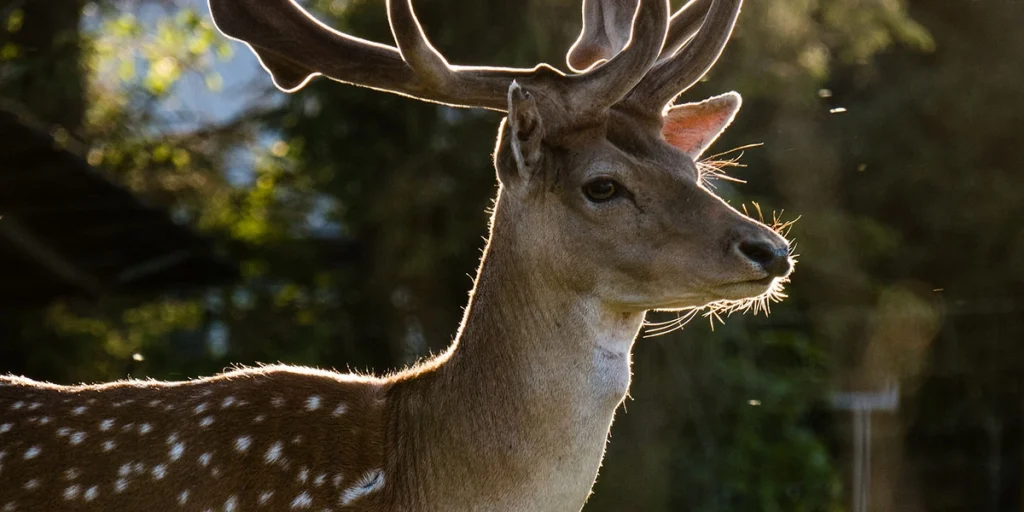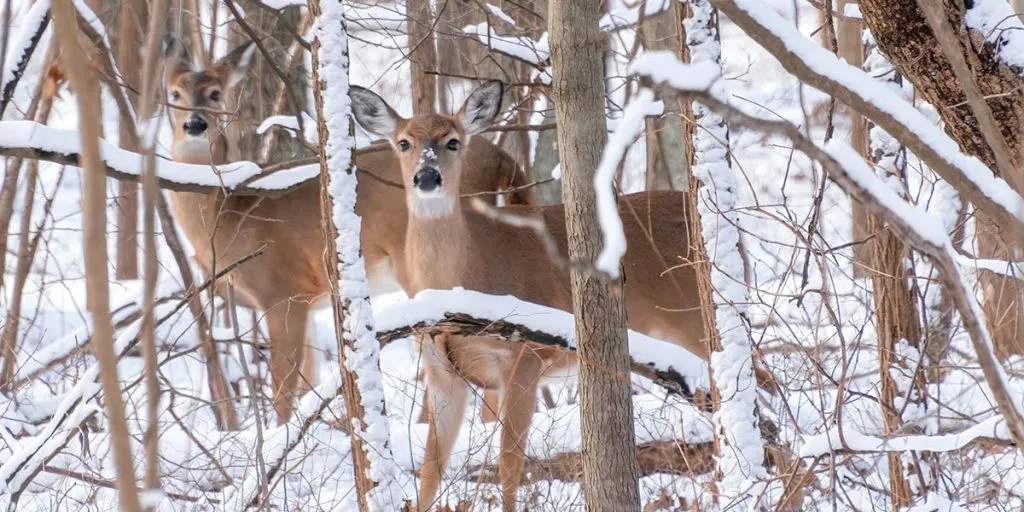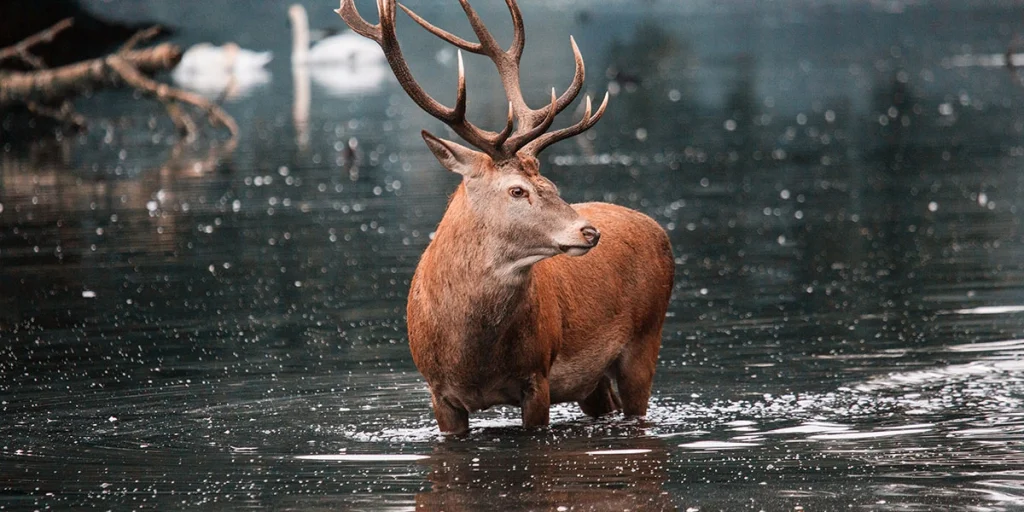The sounds a deer can make are surprisingly varied, and their noises all have interesting meanings. Ranging from a grunt to a bleat, and from a bark to a snort, it takes a bit of learning to understand where to place a deer call in context.
The natural environment is a true cacophony of different animal sounds. Only the practiced ear will know when a buck or doe might be nearby.
This overview will provide you with some insight into some of the more common deer vocalizations. They are the key to understanding their behavior. This can range from two aggressive bucks fighting, all the way to a young fawn making a panicked distress call. Let’s explore the sounds together!
1. Grunting
A social grunting sound is made by a deer to call other members of their group. The vocalization is deep and similar to an “urp” sound. The meaning of the grunt is to make their presence known to other individuals that might be in the area.
Hunters will often use artificial grunt sounds with a deer caller in order to attract more deer to their hunting location.
Male bucks or stags will have a much deeper grunt sound, coming from the bottom of the throat. Bucks will use grunts to assert dominance. When females or does grunt, they sound a little more nasal and high-pitched, she simply uses a grunt for localization purposes.
2. Bleating
Bleating sounds are exclusive to females and baby deer, and the meaning of the sound is simply “Here I am“. The vocalization is used for a variety of reasons, depending on the context.
An adult doe will use a bleat to call their fawns and keep the family together. But during mating season, a doe will also bleat for mating purposes to signal estrus. She uses the bleat vocalization to find an available buck nearby. Hunters might find an adult bleat interesting to attract male deer.
A bleating sound is commonly used by young fawns to call for their mom when they are scared or lost. For baby deer, the sound is a clear, high-pitched, and almost squeaking noise.
2. Snorting
Snorting, blowing, or huffing is used by a deer as a warning sound. The vocalization is made by blowing air out of the nose forcefully. A snorting sound is usually used in combination with intense staring and repeated stomping of the feet.
When deer detect danger within their visual range, the snort is used to warn other deer nearby of danger. Blowing air forcefully through the nose helps the animals to smell the potential threat better. The sound might also intimidate a potential predator, scaring it away in the process.
When a deer snorts at you, it perceives you as a potential threat. In response, you should back away slowly, avoid eye contact, and try not to make any sudden movements. When the deer senses you have moved away far enough, it will eventually turn and run away.
4. Stomping
Not all noises are made with the vocal cords or nostrils. Stomping is an example of such a sound: it is one of the ways in which deer interact with a potential intruder that is spotted nearby.
Stomping sounds are used by deer to lure potential threats into exposing themselves. A stomp will simultaneously be used to alert other deer of the imminent danger. Deer will often use stomping in combination with snorting to assess the potential threat.
Mainly used as a warning, stomping is a sign of anger and frustration. In an extreme situation where no other options are available, it can lead up to a deer attack. The stomping is primarily used as a means to intimidate. It is actually an attempt to avoid conflict where possible.
5. Barking
If a deer barking like a dog seems weird to you, the muntjac deer is probably not known to you. The small, vocal muntjac is known for its barking abilities, which serve a similar purpose to snorting in other deer species. Barking sounds are meant to warn about danger.
A barking muntjac might sound quite frightening from a distance, especially when you don’t really understand what’s going on and the sound is coming from the forest. The sound is similar to a scream, but is distinctly unique to the muntjac:
6. Screaming
Screaming or shrilling are some of the loudest sounds a deer will make. A scream is a sign of immediate danger and panic, and will also be used when the animal is injured (and yes, deer do feel pain). It is a disturbing, powerful vocalization that is likely to cause a lot of stress.
A scream can also be caused by a highly startling moment, one where the animal did not expect a potential threat to be thát close.
The YouTube video below is an example of the screaming sound the animals can make. Please note that it might be a disturbing sound to the ears of our more delicate listeners:
7. Sniffing
One of the more subtle noises made by deer is made as a means of exploration. Deer will make sniffing sounds with their noses when they are curious about their environment and want to explore their surroundings.
It is most likely that you hear deer sniffing around when they have dropped their guard and no longer perceive you as a potential threat.
Using their noses, deer seek out food and can sense which other members of their family are nearby. It also allows them to ‘sniff out’ potential predators. They will also use their noses to recognize humans that might have fed them in the past (don’t do this!).
8. Buck Grunt (Mating Call)
Bucks will make a massive number of vocalizations during rutting season, which is the period at the end of the year when adults try to find a partner. The mating call or buck grunt sounds like a deep-throated belching or groaning sound. The vocalization is meant to attract females and deter other males.
At the same time, a female doe will make her distinctive bleating sounds to attract available males as mentioned before.
Males can perform many thousands of mating calls a day during the rutting season, sometimes up to 3000 times an hour. These are the noises these animals use to make sure the next generation of fawns is born.
9. Rattling
An important part of the mating season (the ‘rut’) is the competition between two males. They will use their impressive antlers to fight for dominance. Rattling is the sound of two antlers intertwining and clashing, and can be heard many times during the rutting season.
When you hear an antler pair rattling during the fall and early winter, you will know that competing deer might be nearby.
Fights can be impressive to watch, but can also be dangerous to unsuspecting bystanders. Always stay away when you notice two bucks fighting, as they might turn on you in a frenzy at any moment. The distinctive sounds of rattling antlers can be heard in the YouTube video below:



